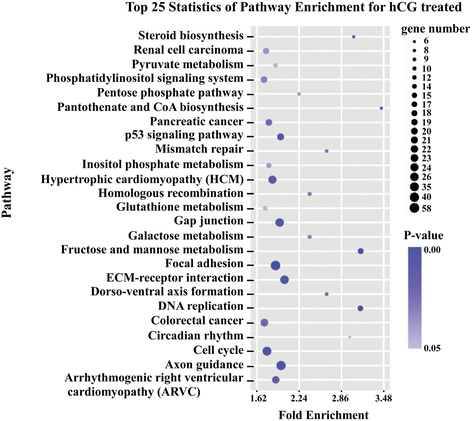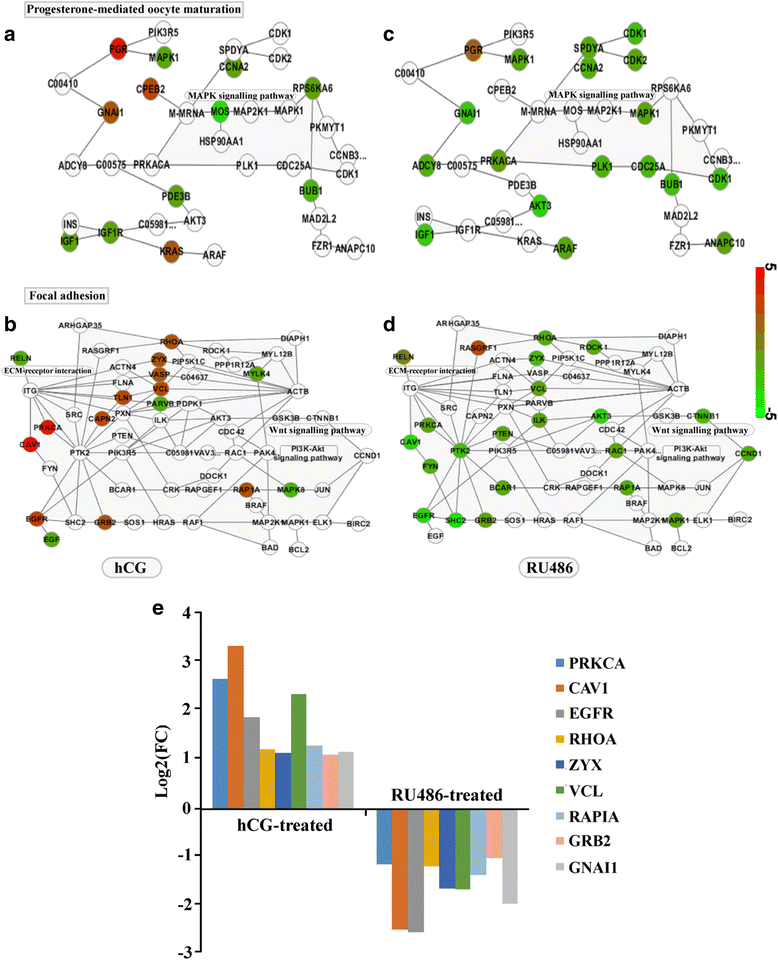Identification of new progestogen-associated networks in mammalian ovulation using bioinformatics
- PMID: 29615037
- PMCID: PMC5883354
- DOI: 10.1186/s12918-018-0577-7
Identification of new progestogen-associated networks in mammalian ovulation using bioinformatics
Abstract
Background: Progesterone plays an essential role in mammalian ovulation. Although much is known about this process, the gene networks involved in ovulation have yet to be established. When analyze the mechanisms of ovulation, we often need to determine key genes or pathways to investigate the reproduction features. However, traditional experimental methods have a number of limitations.
Results: Data, in this study, were acquired from GSE41836 and GSE54584 which provided different samples. They were analyzed with the GEO2R and 546 differentially expressed genes were obtained from two data sets using bioinformatics (absolute log2 FC > 1, P < 0.05). This study identified four genes (PGR, RELN, PDE10A and PLA2G4A) by protein-protein interaction networks and pathway analysis, and their functional enrichments were associated with ovulation. Then, the top 25 statistical pathway enrichments related to hCG treatment were analyzed. Furthermore, gene network analysis identified certain interconnected genes and pathways involved in progestogenic mechanisms, including progesterone-mediated oocyte maturation, the MAPK signaling pathway, the GnRH signaling pathway and focal adhesion, etc. Moreover, we explored the four target gene pathways. q-PCR analysis following hCG and RU486 treatments confirmed the certain novel progestogenic-associated genes (GNAI1, PRKCA, CAV1, EGFR, RHOA, ZYX, VCL, GRB2 and RAP1A).
Conclusions: The results suggested four key genes, nine predicted genes and eight pathways to be involved in progestogenic networks. These networks provide important regulatory genes and signaling pathways which are involved in ovulation. This study provides a fundamental basis for subsequent functional studies to investigate the regulation of mammalian ovulation.
Keywords: Bioinformatics; Mammalian ovulation; Progesterone; Progestogenic-associated.
Conflict of interest statement
Ethics approval and consent to participate
This study does not contain any studies with human participants or animals performed by any of the authors. Informed consent was obtained from all individual participants included in the study.
Consent for publication
Not applicable.
Competing interests
The authors declare that they have no competing interests.
Publisher’s Note
Springer Nature remains neutral with regard to jurisdictional claims in published maps and institutional affiliations.
Figures




Similar articles
-
Identification of new ovulation-related genes in humans by comparing the transcriptome of granulosa cells before and after ovulation triggering in the same controlled ovarian stimulation cycle.Hum Reprod. 2014 May;29(5):997-1010. doi: 10.1093/humrep/deu008. Epub 2014 Feb 7. Hum Reprod. 2014. PMID: 24510971
-
Bioinformatics-Based Identification of Methylated-Differentially Expressed Genes and Related Pathways in Gastric Cancer.Dig Dis Sci. 2017 Nov;62(11):3029-3039. doi: 10.1007/s10620-017-4740-6. Epub 2017 Sep 15. Dig Dis Sci. 2017. PMID: 28914394
-
High-efficient Screening Method for Identification of Key Genes in Breast Cancer Through Microarray and Bioinformatics.Anticancer Res. 2017 Aug;37(8):4329-4335. doi: 10.21873/anticanres.11826. Anticancer Res. 2017. PMID: 28739725
-
Identification of key genes and associated pathways in KIT/PDGFRA wild‑type gastrointestinal stromal tumors through bioinformatics analysis.Mol Med Rep. 2018 Nov;18(5):4499-4515. doi: 10.3892/mmr.2018.9457. Epub 2018 Sep 5. Mol Med Rep. 2018. PMID: 30221743 Free PMC article.
-
Analyzing the LncRNA, miRNA, and mRNA Regulatory Network in Prostate Cancer with Bioinformatics Software.J Comput Biol. 2018 Feb;25(2):146-157. doi: 10.1089/cmb.2016.0093. Epub 2017 Aug 24. J Comput Biol. 2018. PMID: 28836827
Cited by
-
Phosphodiesterase 10A (PDE10A) as a novel target to suppress β-catenin and RAS signaling in epithelial ovarian cancer.J Ovarian Res. 2022 Nov 2;15(1):120. doi: 10.1186/s13048-022-01050-9. J Ovarian Res. 2022. PMID: 36324187 Free PMC article.
-
Quantitative proteomic analysis and verification identify global protein profiling dynamics in pig during the estrous cycle.Front Vet Sci. 2023 Sep 28;10:1247561. doi: 10.3389/fvets.2023.1247561. eCollection 2023. Front Vet Sci. 2023. PMID: 37841454 Free PMC article.
-
Neurotensin: a neuropeptide induced by hCG in the human and rat ovary during the periovulatory period†.Biol Reprod. 2021 Jun 4;104(6):1337-1346. doi: 10.1093/biolre/ioab036. Biol Reprod. 2021. PMID: 33682882 Free PMC article.
-
Puberty classifications in beef heifers are moderately to highly heritable and associated with candidate genes related to cyclicity and timing of puberty.Front Genet. 2024 Jun 13;15:1405456. doi: 10.3389/fgene.2024.1405456. eCollection 2024. Front Genet. 2024. PMID: 38939530 Free PMC article.
-
Transcriptomic Analysis Reveals Differentially Expressed Circular RNAs Associated with Fecundity in the Sheep Hypothalamus with Different FecB Genotypes.Animals (Basel). 2024 Jan 7;14(2):198. doi: 10.3390/ani14020198. Animals (Basel). 2024. PMID: 38254366 Free PMC article.
References
Publication types
MeSH terms
Substances
LinkOut - more resources
Full Text Sources
Other Literature Sources
Molecular Biology Databases
Research Materials
Miscellaneous

